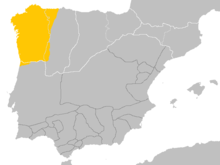Galician–Portuguese
Galician-Portuguese is a branch of Romance languages. They were first spoken in Northwestern Iberia and spread to the south. They are now spoken in all of Portugal and Northwestern Spain. The main two languages are Galician and Portuguese. All Galician-Portuguese languages were once all the same language, but have since split. Portuguese was spread to Brazil during the colonial era and it is also now spoken there.[2]
| Galician–Portuguese | |
|---|---|
| Galaic–Portuguese, Old Galician–Portuguese, Old Galician, Old Portuguese, Medieval Galician, Medieval Portuguese | |
| romanço, romançe, rimanço | |
| Native to | Kingdom of Galicia, County of Portugal |
| Region | Northwestern Iberia |
| Era | Attested 870 A.D.; by 1400 had split into Galician, Fala, and Portuguese.[1] |
Indo-European
| |
Early forms | |
| Language codes | |
| ISO 639-3 | – |
079 | |
| Glottolog | None |
 Spoken area of Galician–Portuguese in the Kingdom of León around the 10th century, before the separation of the Galician and Portuguese languages. | |
Vowels
change| Front | Central | Back | |
|---|---|---|---|
| Close | i | u | |
| Near-close | (ʊ) | ||
| Close-mid | e | o | |
| Open-mid | ɛ | ɔ | |
| Open | ä |
| Front | Central | Back | |
|---|---|---|---|
| Close | ĩ | ũ | |
| Close-mid | ẽ | õ | |
| Open-mid | ä̃ |
As far as it is known, Galician-Portuguese (from 11th to 16th centuries) had possibly a 7-oral-vowel system /ä, e, ɛ, i, o, ɔ, u, ʊ/ (like in most of Romance languages) and a 5-nasal-vowel system /ä̃, ẽ, ĩ, õ, ũ/. The vowels /e – ɛ, o – ɔ/ were lowered to /e, o/ in unstressed syllables, even in final syllables (like in modern Spanish); e.g. vento /vẽto/, quente ['kẽte].
In Portugal the Galician /o/ in final syllables and unstressed is lowered to /ʊ/ that remained in Brazilian Portuguese but in Modern European Portuguese became /o/ and /u/ depending on the words and dialects.
However, the /a – ɐ/ distribution (including /ɐ̃/) is still dubious and under discussion; some either stating that these two vowels were allophones and in complementary distribution (like in Spanish and Modern Galician, only treated as /a/), Alemanha, manhã /ale'maɲa, ma'ɲã/; or stating they were not allophones and under distribution like in European Portuguese nowadays, Alemanha, manhã /ɐle'mɐɲɐ, mɐ'ɲɐ̃/.[3]
References
change- ↑ Galician–Portuguese at MultiTree on the Linguist List
- ↑ Maia, Clarinda de Azevedo (1997). História do galego-português: estado linguístico da Galiza e do noroeste de Portugal desde o século XIII ao século XVI (com referência à situação do galego moderno) [History of Galician-Portuguese: linguistic state of Galicia and Northwest Portugal from the 13th to the 16th centuries: (with reference to the situation of modern Galician)] (in Portuguese) (Reimpressã da edição do INIC (1986) ed.). Lisboa: Fundação Calouste Gulbenkian. pp. 883–891. ISBN 9789723107463.
- ↑ "As diferenças na pronúncia medieval em relação ao português moderno" [Differences in medieval pronunciation in relation to modern Portuguese]. Ciberdúvidas da Língua Portuguesa (in Portuguese).